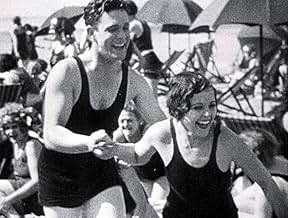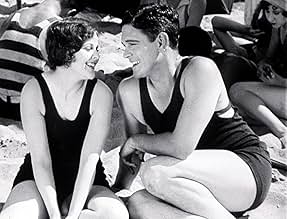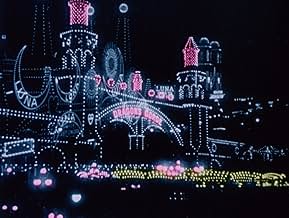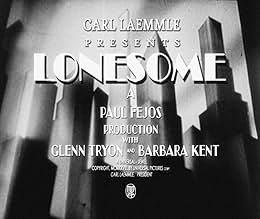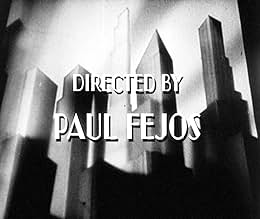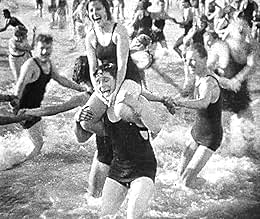IMDb RATING
7.7/10
2.8K
YOUR RATING
Two lonely people in the big city meet and enjoy the thrills of an amusement park, only to lose each other in the crowd after spending a great day together. Will they ever see each other aga... Read allTwo lonely people in the big city meet and enjoy the thrills of an amusement park, only to lose each other in the crowd after spending a great day together. Will they ever see each other again?Two lonely people in the big city meet and enjoy the thrills of an amusement park, only to lose each other in the crowd after spending a great day together. Will they ever see each other again?
- Awards
- 1 win total
Gusztáv Pártos
- Romantic Gentleman
- (as Gustav Partos)
Henry Armetta
- Ferris wheel guy
- (uncredited)
Edgar Dearing
- Cop
- (uncredited)
Louise Emmons
- Telephone Caller
- (uncredited)
Fred Esmelton
- Swami
- (uncredited)
Jack Raymond
- Barker
- (uncredited)
Churchill Ross
- Telephone Caller
- (uncredited)
Featured reviews
There are at least three levels at which 'Lonesome' is an extremely interesting film.
1. It is a sweet story of two lonely people in a big anonymous city who meet, fall in love and lose each other. The picture is well-acted, and the two lead actors Barbara Kent (Mary) and Glenn Tryon (Jim) are perfectly matched; they both give nuanced and sensitive performances.
2. The style of the picture is almost documentary, which makes it interesting from a social history point of view. In some ways, nothing much has changed over the last 100 years: People are still commuting to work, the subway in New York was as crowded as the London Underground is today (I don't know about New York in 2022), you get annoyed at the same kind of behaviour of your fellow passengers (e.g. Eating smelly food) etc. Obviously other things have changed: The type of work we do, for example, and we no longer bond over serialised novels published in newspapers that we read. Nevertheless, we are still living in what is recognisably the same kind of society. I found this aspect of 'Lonesome' particularly interesting.
3. Technologically, 'Lonesome' was highly innovative, being the perfect example of a film that came out during the transition phase from silent pictures to talkies to colour films. Initially, it looks like a normal black and white silent film to which music and some sound effects have been added. However, some scenes have spoken dialogue, and some are even in colour, or at least partly colorised. People back then must have felt they were living in an exciting age of innovation; I am sure they expected that within the next few years, all talking and maybe even all colour films would become the norm.
So why am I giving 'Lonesome' no more than 8 stars? Well, there are a few flaws. First, the dialogue sounds as stilted as if the actors were reading it from a sheet, and on top of that, a bit of it does not seem to make much sense (the scene at the police). It feels like an afterthought, like something director Pal Fejös inserted after having finished the rest of the film. Second, the colour effects are not particularly nice to look at. The colours are just garish. They were certainly innovative, but the film would look better without them. And finally, the plot is so simple that it barely exists. The only real problem the characters face appears almost at the end of the film, and its resolution does not logically follow from anything that happened earlier; it just comes about by chance. I am reserving 9 stars for pictures that are as good as perfect, and 10 for those that have some particular emotional quality or style that takes them into the small group of my favourite films (like e.g. 'North by Northwest', which for my taste must be one of the most stylish films ever made). 'Lonesome' is very good, but not as good as that. Hence 8 stars.
1. It is a sweet story of two lonely people in a big anonymous city who meet, fall in love and lose each other. The picture is well-acted, and the two lead actors Barbara Kent (Mary) and Glenn Tryon (Jim) are perfectly matched; they both give nuanced and sensitive performances.
2. The style of the picture is almost documentary, which makes it interesting from a social history point of view. In some ways, nothing much has changed over the last 100 years: People are still commuting to work, the subway in New York was as crowded as the London Underground is today (I don't know about New York in 2022), you get annoyed at the same kind of behaviour of your fellow passengers (e.g. Eating smelly food) etc. Obviously other things have changed: The type of work we do, for example, and we no longer bond over serialised novels published in newspapers that we read. Nevertheless, we are still living in what is recognisably the same kind of society. I found this aspect of 'Lonesome' particularly interesting.
3. Technologically, 'Lonesome' was highly innovative, being the perfect example of a film that came out during the transition phase from silent pictures to talkies to colour films. Initially, it looks like a normal black and white silent film to which music and some sound effects have been added. However, some scenes have spoken dialogue, and some are even in colour, or at least partly colorised. People back then must have felt they were living in an exciting age of innovation; I am sure they expected that within the next few years, all talking and maybe even all colour films would become the norm.
So why am I giving 'Lonesome' no more than 8 stars? Well, there are a few flaws. First, the dialogue sounds as stilted as if the actors were reading it from a sheet, and on top of that, a bit of it does not seem to make much sense (the scene at the police). It feels like an afterthought, like something director Pal Fejös inserted after having finished the rest of the film. Second, the colour effects are not particularly nice to look at. The colours are just garish. They were certainly innovative, but the film would look better without them. And finally, the plot is so simple that it barely exists. The only real problem the characters face appears almost at the end of the film, and its resolution does not logically follow from anything that happened earlier; it just comes about by chance. I am reserving 9 stars for pictures that are as good as perfect, and 10 for those that have some particular emotional quality or style that takes them into the small group of my favourite films (like e.g. 'North by Northwest', which for my taste must be one of the most stylish films ever made). 'Lonesome' is very good, but not as good as that. Hence 8 stars.
... and I could say the same thing about Fejos' "Broadway", made a year later. Fejos recounts the tale of two lonely New Yorkers, Jim (Glen Tryon) and Mary (Barbara Kent), who find love and each other during a half day holiday at the beach and Coney Island. You first see the workday from Jim and Mary's perspective as they are ruled first by the tyranny of the alarm clock and then the tedium of the workday as you see a clock overlaying the image of each at work. Jim is a low-level machine operator, and Mary is a telephone operator. Then there are "the crowds". Jim and Mary are crowded at breakfast, at a diner filled with patrons, crowded on the subway, crowded at work, and crowded at the beach and amusement park. Yet both of them are completely alone in the world, which, especially in the attractive Miss Kent's case, seems somewhat inconceivable.
This late era silent has a dearth of title cards, which does not subtract from the film's enjoyment. In fact, what does subtract just a little are the short dialogue scenes that just don't make sense. One scene is Jim and Mary on the beach suddenly in the dark AND in color, with the crowd removed. Nothing they say shines any light on their situation or feelings at all. Another one is in a courtroom where Jim has been detained for being unruly. He gives a speech like a Bolshevik basically shaming the judge and ... the judge lets him go???? This social awareness seems very strange stuff coming from Jim who, up to that point, has seemed to be a very uncomplicated fellow. Very strange, but typical of talking scenes inserted into silent films at the dawn of sound.
What is extra special about this film is to see the lives of working class people in 1928. Notice that the workday that Jim and Mary are going through is a Saturday, and this was the norm back then and until some time after WWII. People would normally work half a day on Saturday and have only Sunday in its entirety as a day off. Catch this film if you can, even if you are not a huge silent film buff.
This late era silent has a dearth of title cards, which does not subtract from the film's enjoyment. In fact, what does subtract just a little are the short dialogue scenes that just don't make sense. One scene is Jim and Mary on the beach suddenly in the dark AND in color, with the crowd removed. Nothing they say shines any light on their situation or feelings at all. Another one is in a courtroom where Jim has been detained for being unruly. He gives a speech like a Bolshevik basically shaming the judge and ... the judge lets him go???? This social awareness seems very strange stuff coming from Jim who, up to that point, has seemed to be a very uncomplicated fellow. Very strange, but typical of talking scenes inserted into silent films at the dawn of sound.
What is extra special about this film is to see the lives of working class people in 1928. Notice that the workday that Jim and Mary are going through is a Saturday, and this was the norm back then and until some time after WWII. People would normally work half a day on Saturday and have only Sunday in its entirety as a day off. Catch this film if you can, even if you are not a huge silent film buff.
If only this remarkable movie hadn't had the misfortune to be released just when the enthusiasm for sound was sweeping all before it, it would probably have been more appreciated at the time and remembered today as one of the all-time classics. As an expression of the isolation of city life, it builds up an atmosphere of desperation, in spite of its romance with a happy ending. The scene where the boy searches frantically for the girl throughout crowded Coney Island, buffeted this way and that by the uncaring throngs, turned away by the indifferent faces of the amusement park workers, has few equals for anguish. Also unforgettable is the montage that cuts from one to the other of the lovers (who have not yet met) while they are at work, the one at a factory, the other at a telephone switchboard; the motions of the hands and the machines build to a frantic, overwhelming pace.
Unfortunately, before the movie was released it was sadly mangled by the insertion of several sound sequences, which stop the continuity dead with their absolute stasis, and feature dialogue so thunderously inane you have to suspect it was written by the sound technician. Nonetheless, "Lonesome" remains one of the most sophisticated examples of the silent movie, an art form that was killed by sound almost as soon as it had reached maturity.
Unfortunately, before the movie was released it was sadly mangled by the insertion of several sound sequences, which stop the continuity dead with their absolute stasis, and feature dialogue so thunderously inane you have to suspect it was written by the sound technician. Nonetheless, "Lonesome" remains one of the most sophisticated examples of the silent movie, an art form that was killed by sound almost as soon as it had reached maturity.
Silent movies had a unique appeal to viewers in early cinema in that they forced the public to use their imaginations to fill in the gaps when the characters were speaking to one another. Silents didn't require extensive inter titles to get the jest of the actors' conversations. Consequently, the actors became larger than life because they weren't dragged down by imperfections in tonality and delivery most mortals possess.
So when the first 'talkies' starting dribbling out of Hollywood after October 1927's "The Jazz Singer" was released, the voices emitting from the screen must have been jarring to those not used to hearing their acting idols speak. One of the first feature films after "The Jazz Singer" to contain a bit of audible dialogue was June 1928's "Lonesome." The film was initially released as a silent, then in September edited with three sequences of actual talking. The first talking sequence is 30 minutes into the film when Mary (Barbara Kent) and Jim (Glenn Tryon), meeting for the first time at Coney Island's amusement park, are sitting on the beach saying how lucky they are meeting each other. As one modern-day critic describes it, "They suddenly seemed very childlike and embarrassing compared to their 'silent selves,' perhaps even silly and sappy. They seemed flawed and human once I heard their voices. It was an interesting way for me to think about silence versus sound in cinema, as this film allows one to essentially to see both types in the same film."
Film critic Andrew Saris claimed "Lonesome" was "a tender love story in its silent passages, but crude, clumsy and tediously tongue-tied in its talkie passages." There is one sequence in the dialogue portion that justifies the talkie addition. Jim gets hauled into the police station after a cop accused him of roughing him up after he tried break through the crowd to get to Mary, who had fainted. The police commander, debating whether to charge Jim, at first plays hardball. But when Jim pleads his case, you can hear the change of tone of the adjudicating official when he decides to let him go. An inter title could never convey such a friendlier timbre of the officer.
The appeal of "Lonesome" is that the Paul Fejos-directed movie addresses a universal problem focused on singles living a solitary life in the big city. Jim, a keypunch machine operator at a city factory, and Mary, a telephone operator, work long hours. Their opportunities to meet the opposite sex are few. Fejos, a former medic with the Austrian Army on the front lines of World War One front lines whose love for theater transformed into directing film, used a bag of special effects tricks early on to cleverly portray the pair, using double exposures to show their routine day. The two do link up at the park and have a magical time staring into each other's eyes. Fejos colors his celluloid with hand-tinted and stencil-color segments to illustrate their romantic state.
Once "Lonesome" was released in June, Universal Studio executives felt adding the talking sequences to the movie would add some pizzazz. The studio borrowed a Movietone News sound recording truck from Fox Pictures, owners of the audio system, on the pretext it was conducting sound tests when actually it was filming the three audible sequences. Fejos wasn't involved in those shoots, which didn't dampen critics' enthusiasm for the film, citing it as the highlight of his career. "Lonesome" was a great success for Universal, partly because of the revolutionary insertion of those "talking" segments.
So when the first 'talkies' starting dribbling out of Hollywood after October 1927's "The Jazz Singer" was released, the voices emitting from the screen must have been jarring to those not used to hearing their acting idols speak. One of the first feature films after "The Jazz Singer" to contain a bit of audible dialogue was June 1928's "Lonesome." The film was initially released as a silent, then in September edited with three sequences of actual talking. The first talking sequence is 30 minutes into the film when Mary (Barbara Kent) and Jim (Glenn Tryon), meeting for the first time at Coney Island's amusement park, are sitting on the beach saying how lucky they are meeting each other. As one modern-day critic describes it, "They suddenly seemed very childlike and embarrassing compared to their 'silent selves,' perhaps even silly and sappy. They seemed flawed and human once I heard their voices. It was an interesting way for me to think about silence versus sound in cinema, as this film allows one to essentially to see both types in the same film."
Film critic Andrew Saris claimed "Lonesome" was "a tender love story in its silent passages, but crude, clumsy and tediously tongue-tied in its talkie passages." There is one sequence in the dialogue portion that justifies the talkie addition. Jim gets hauled into the police station after a cop accused him of roughing him up after he tried break through the crowd to get to Mary, who had fainted. The police commander, debating whether to charge Jim, at first plays hardball. But when Jim pleads his case, you can hear the change of tone of the adjudicating official when he decides to let him go. An inter title could never convey such a friendlier timbre of the officer.
The appeal of "Lonesome" is that the Paul Fejos-directed movie addresses a universal problem focused on singles living a solitary life in the big city. Jim, a keypunch machine operator at a city factory, and Mary, a telephone operator, work long hours. Their opportunities to meet the opposite sex are few. Fejos, a former medic with the Austrian Army on the front lines of World War One front lines whose love for theater transformed into directing film, used a bag of special effects tricks early on to cleverly portray the pair, using double exposures to show their routine day. The two do link up at the park and have a magical time staring into each other's eyes. Fejos colors his celluloid with hand-tinted and stencil-color segments to illustrate their romantic state.
Once "Lonesome" was released in June, Universal Studio executives felt adding the talking sequences to the movie would add some pizzazz. The studio borrowed a Movietone News sound recording truck from Fox Pictures, owners of the audio system, on the pretext it was conducting sound tests when actually it was filming the three audible sequences. Fejos wasn't involved in those shoots, which didn't dampen critics' enthusiasm for the film, citing it as the highlight of his career. "Lonesome" was a great success for Universal, partly because of the revolutionary insertion of those "talking" segments.
10Varlaam
This film is outstanding.
A man and woman leave their respective rented rooms for work. He's a "punch presser"; she's a switchboard operator. After work, neither one feels up to joining friends; they just feel too ... single. But they both head to Coney Island. They meet, fall in love, get separated, return home distressed. A plot that simple, even clichéd, does not appear to hold much promise.
But the energy! The pacing is so frenetic. There's constant movement on camera, clocks ticking, crowds scurrying, throngs crushing, machines stamping, carnivals, streamers, roller coaster rides. Moments of relative calm come when the lovers are together.
The thrilling impersonality of the urban maelstrom has hardly been better depicted. I came away thinking it was one of the best things I've seen.
If you've seen "The Devil and Miss Jones", the Jean Arthur / Robert Cummings comedy from 1941, then you can't help but remember the Coney Island beach scene where everyone is packed in together with barely room to move.
Well, this film has a scene just like that one. In fact, the greater part of the film is that way. You're never so alone as when you're in a crowd. These scenes are funny, but they do make their point.
I saw a restored print of "Solitude" (as it was titled) with colour tinting and three sound sequences, courtesy of Cinematheque Ontario. The sound segments are just awful, so typical of the very earliest sound, but perhaps they're a blessing in disguise. The extraordinary quality of the silent film is spotlighted by the awkwardness of these three brief scenes: Jim and Mary on the beach, Jim and Mary near the midway, Jim at the police station.
The ultimate restoration of this elusive marvel would make the film silent throughout, liberating it from the stylistic cacophony of the stilted sound sequences.
Neither lead performer, Barbara Kent nor Glenn Tryon, was known to me previously. (Andy Devine is plainly recognizable however.) It seems that Tryon later became the producer of "Hellzapoppin" and "Hold That Ghost". He also holds the only acting credit for a film that anyone at all seems to have seen, "Variety Girl" from 1947. To me, Barbara Kent resembles Paulette Goddard somewhat, while Glenn Tryon looks like a brother to Don DeFore and Bob Cummings.
The screening I attended was the Toronto première of the restoration. Let's hope it now becomes more widely available.
A man and woman leave their respective rented rooms for work. He's a "punch presser"; she's a switchboard operator. After work, neither one feels up to joining friends; they just feel too ... single. But they both head to Coney Island. They meet, fall in love, get separated, return home distressed. A plot that simple, even clichéd, does not appear to hold much promise.
But the energy! The pacing is so frenetic. There's constant movement on camera, clocks ticking, crowds scurrying, throngs crushing, machines stamping, carnivals, streamers, roller coaster rides. Moments of relative calm come when the lovers are together.
The thrilling impersonality of the urban maelstrom has hardly been better depicted. I came away thinking it was one of the best things I've seen.
If you've seen "The Devil and Miss Jones", the Jean Arthur / Robert Cummings comedy from 1941, then you can't help but remember the Coney Island beach scene where everyone is packed in together with barely room to move.
Well, this film has a scene just like that one. In fact, the greater part of the film is that way. You're never so alone as when you're in a crowd. These scenes are funny, but they do make their point.
I saw a restored print of "Solitude" (as it was titled) with colour tinting and three sound sequences, courtesy of Cinematheque Ontario. The sound segments are just awful, so typical of the very earliest sound, but perhaps they're a blessing in disguise. The extraordinary quality of the silent film is spotlighted by the awkwardness of these three brief scenes: Jim and Mary on the beach, Jim and Mary near the midway, Jim at the police station.
The ultimate restoration of this elusive marvel would make the film silent throughout, liberating it from the stylistic cacophony of the stilted sound sequences.
Neither lead performer, Barbara Kent nor Glenn Tryon, was known to me previously. (Andy Devine is plainly recognizable however.) It seems that Tryon later became the producer of "Hellzapoppin" and "Hold That Ghost". He also holds the only acting credit for a film that anyone at all seems to have seen, "Variety Girl" from 1947. To me, Barbara Kent resembles Paulette Goddard somewhat, while Glenn Tryon looks like a brother to Don DeFore and Bob Cummings.
The screening I attended was the Toronto première of the restoration. Let's hope it now becomes more widely available.
Did you know
- TriviaIt was one of the first motion pictures to have sound and a couple of talking scenes. It was released in both silent and monaural versions. Some scenes in existing original prints of the film are colored with stencils.
- Alternate versionsProduced in both sound and silent versions. The sound version was 6,785 feet in length, and the silent version was 6,193 feet.
- ConnectionsFeatured in Fejezetek a film történetéböl: Az amerikai film kezdetei (1989)
- SoundtracksAlways
(uncredited)
Written by Irving Berlin
[Played by dance orchestra at ballroom]
Sung by Nick Lucas
[on Brunswick recording played in last scene]
- How long is Lonesome?Powered by Alexa
Details
- Runtime
- 1h 9m(69 min)
- Sound mix
- Aspect ratio
- 1.19:1
Contribute to this page
Suggest an edit or add missing content



